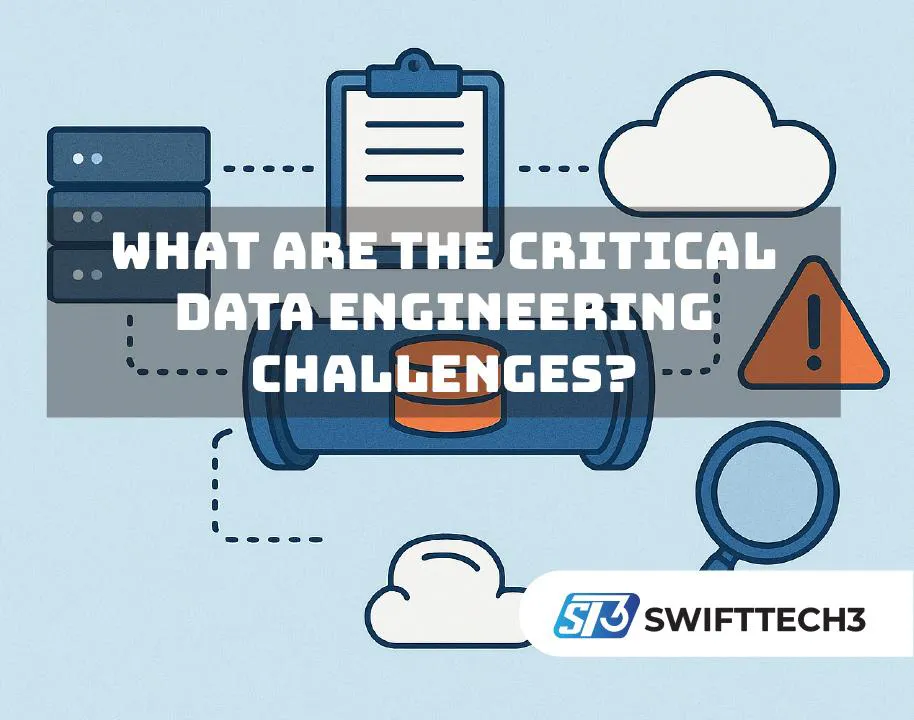In today’s digital world, data powers almost everything—from recomendation systems on e-commerce sites to fraoud detection in banking. But before bussinesses can use this data efectively, it must be collected, clean, stored, and made accesible. This is where data enginering comes in.
Data enginering plays a crutial role in preparing data for analitics, reporting, and advance technologies like Machine Learning Development Servises. However, it’s not always a smooth jorney. Companys face several chalenges when building and maintaning roboust data pipelins. Let’s explore the most criticel ones.
1. Data Collection from Multiple Sources
Modern bussinesses don’t rely on just one source of data. Instead, they gathers it from multipal platforms such as CRMs, IoT devices, websites, social medias, and third-party API’s. Each source may uses differnt formats, structures, and standerds.
Example:
Imagine a retailer collecting costumer purchase data from a e-commerce platform, loyality programs, and in-store transcations. Combinng all these without errors is a tough tasks.
The Challenge:
Inconsistant file formats (CSV, JSON, XML).
Real-time vs. batch data stream.
Duplicate or missing value.
Why it matters: Poor data collection strategy leads to incompleted datasets, making it harder for teams to trust the insight generated.
2. Data Quality and Cleansing
Raw data is often mess. It can include speling mistakes, outdate information, or even duplicate entry. Poor-quality data result in unreliable analytic and flawed machine learning model.
Example:
If a financial firm feed inaccurate transaction records into a fraoud detection system, it might either flag too many false positive or miss real fraudulent activity.
The Challenge:
Detecting error in huge datasets.
Standerdizing inconsistant formats (e.g. date format).
De-duplicating costumer records.
Why it matters: Clean data ensure that bussiness can rely on their report and predictive model. It’s also a critcal foundation for Machine Learning Consultancy project.
3. Scalability of Data Infrastructure
As bussiness grows, so does the amout of data they generates. A system that work for thousand of records may fail when face with billions. Scaling infrastucture without causing downtime or loosing data is one of the tough parts of data enginering.
Example:
A streaming service may start with few thousand daily viewer. But once it scale to milions, the data pipline must handle massive real-time video consumtion analytic.
The Challenge:
Expenssive cloud storage and compute resorces.
Balancing real-time and batch prosessing.
Maintaning speed without sacrficing accuracy.
Why it matters: Without scalable infrastucture, bussiness risk bottlenecks that slow decision making.
4. Security and Compliance
Data is valuble, but it’s also sensetive. Personal data like names, emails, and payment information must be protect under laws like GDPR and CCPA. Failure to complie can lead to massive fine and reputational damge.
Example:
A healthcare provider handling patient record must encript sensetive data and controll access while still alowing data scientist to analize trend for better treatment.
The Challenge:
Managng data encryption at scale.
Setting strict access controlls.
Attack Surface Management (ASM)
Meeting complience requirements across multipl regions.
Why it matters: Security laps can destroy costumer trust, making complience a non-negotiable part of data enginering.
5. Integration with Machine Learning Workflows
Data enginering doesn’t stop at storage. The ultmate goal for many bussiness is to feed data into analytic platform or machine learning model. If data pipline not designed to integrate smooth with ML workflows, project get stall.
Example:
An online marketpalce may wants to implement personalized product recomendations. If the data pipline isn’t optimize for real-time update, recomndations may be outdated or irrelevent.
The Challenge:
Building pipline that supports real-time machine learning.
Handling versioning of dataset.
Ensuring data consistancy for training and testing model.
Why it matters: Company that invest in Machine Learning Development Services rely on data enginering to supply accurate, timely data. A weak pipline undermines the hole process.
6. Monitoring and Maintenance
Data pipline are not “set it and forget it.” They need constent monitoring to detect failure, performence bottleneks, and data delay. Without proper maintaince, even small issue can snowball into major disruprtions.
Example:
A delievery company may experiance delay in updating tracking informations. If not monitred, the error could mislead thousand of customers waiting for pakages.
The Challenge:
Automating monitor processes.
Quickly identifing and fixing broken pipline.
Balancing human oversite with automted alerts.
Why it matters: Continous maintaince ensure data flow smooth and prevent downtime for analytic and machine learning system.
7. Cost Optimization
Cloud platfrom like AWS, Azure and Google Cloud has made it easier to store and process data, but cost can spiral out of controll. Poorly optimized pipline may lead to high storage fee, redundant prosessing, or underutilized resorces.
Example:
A company storing raw and process datasets without delet policy might end up paying for terabite of unneccessary storage.
The Challenge:
Predictng long-term infrastucture need.
Avoiding over-provision of cloud resorces.
Balancing performence with affodability.
Why it matters: Optimized pipline helps bussiness get the most value out of there data without over spending.
Final Thoughts
Data enginering is the backone of modern digital bussiness. From ensuring data quality to manage complience and scalability, enginers face numerus chalenges everyday. Overcome these hurdels is essential for company that want to suceed in data-driven decision making and advance technologies.
For organizations investing in Machine Learning Consultency or Machine Learning Development Servises, strong data enginering practises are non-negotiable. Without them, machine learning model can’t deliver accurate prediction or insight.
By adressing these challanges with the right stratgy, tools and experties, bussiness can unlock the full potantial of there data and gain a compettive edge.

FAQ’s
Data enginering make sure that data is clean, organize and easy to use for reports or machine learning model. Without it, decision become slow and analytic result can be wrong or incomplete.
Common tools include Apache Spark, Hadoop, Airflow and cloud platform like AWS or Google Cloud. But the right tools depend on the bussiness size, type of data and how often it needs to be process.


